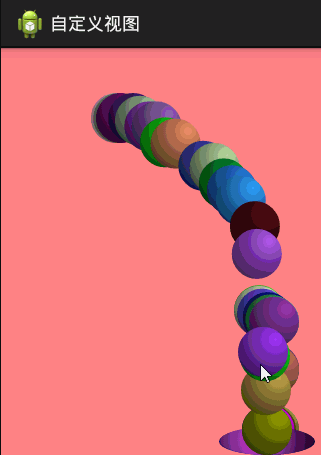《Android動畫高手成長記》跳跳球效果
在介紹本文動畫效果實現之前,先來介紹屬性動畫相關的幾個知識點。
- ValueAnimator與ObjectAnimator。
- Interpolator插值器與TypeEvaluator估值器。
在Android3.0之前,系統提供了兩種動畫效果實現方式,幀動畫frame-by-frame animation和補間動畫tweened animation。幀動畫就是類似電影播放一樣,將整部影片拆分成一片片的然後連貫起來播放。補間動畫則可以實現對view的縮放、平移、旋轉等操作。在3.0之後,出現了一種新的動畫模式稱為屬性動畫property animation。
屬性動畫產生的原因
屬性動畫的出現不是用來替代補間動畫的,而是用來解決補間動畫所不能夠完成的事件的。如果我們的需求超出了操控view的旋轉、縮放、平移等操作範圍,那麼我們就需選擇屬性動畫去實現了。那麼屬性動畫可以做到哪些補間動畫做不到的事情呢?下面列舉幾點,當然屬性動畫的功能很強大,不僅限於我列舉的幾點。
- 屬性動畫可以做到對一個非view類進行動畫操作。
- 屬性動畫可以做到真正的改變view物件的屬性值。而補間動畫只是改變了view的動畫效果。
ValueAnimator與ObjectAnimator
ObjectAnimator是屬性動畫中最總要的執行類,ObjectAnimator可以操作某個物件的屬性值,但是這個屬性值必須要有get和set方法,同時也可以設定view的執行線路,通過插值器來控制。
舉個簡單的例子:
ObjectAnimator
.ofFloat(view, "rotationY", 0.0F, 360.0F)
.setDuration(500)
.start();
其可操作的屬性有x/y;scaleX/scaleY;rotationX/ rotationY;transitionX/ transitionY等。
上面的例子是修改view的單個屬性值,同樣也可以同時修改多個屬性,下面介紹兩種
PropertyValuesHolder屬性值持有者
PropertyValuesHolder pvhLeft = PropertyValuesHolder.ofInt("left", 0, 1); PropertyValuesHolder pvhTop = PropertyValuesHolder.ofInt("top", 0, 1); ObjectAnimator.ofPropertyValuesHolder( this, pvhLeft, pvhTop).提供一個不存在的屬性值
ObjectAnimator anim = ObjectAnimator.ofFloat(view, "long", 1.0F, 0.0F).setDuration(500); anim.start(); anim.UpdateListener(new AnimatorUpdateListener() { @Override public void onAnimationUpdate(ValueAnimator animation) { float cVal = (Float) animation.getAnimatedValue(); view.setAlpha(cVal); view.setScaleX(cVal); view.setScaleY(cVal); } });
上面提到的都是修改物件已有的setter和getter方法的屬性值。那麼如果物件沒有為某個屬性提供提供setter和getter方法呢,我們也可以做到修改這些屬性值,下面提供兩種實現方式:
- 通過valueAnimation來實現,這個下面會講解。
通過自己寫一個包裝類來實現。然後為該屬性提供setter和getter方法。
class ViewWrapper{ private View mView; public int getWidth(){ return mView.getLayoutParams().width; } }
ValueAnimator包含Property Animation動畫的所有核心功能,如動畫時間,開始、結束屬性值,相應時間屬性值計算方法等。
屬性動畫的應用有兩個步驟:
1、計算屬性的值。2、根據屬性值執行相應的動作。
ValueAnimator只是完成了第一步驟,而要完成第二步還要藉助於ValueAnimator.onUpdateListener介面,在此方法中可以通過ValueAnimator物件的getAnimatedValue()函式可以得到當前的屬性值。
ValueAnimator animation = ValueAnimator.ofFloat(0f, 1f);
animation.setDuration(1000);
animation.addUpdateListener(new AnimatorUpdateListener () {
@Override
public void onAnimationUpdate(ValueAnimator animation) {
Log.i("update", ((Float)animation.getAnimatedValue()).toString());
// 此處可以根據getAnimatedValue獲取到的屬性值改變view相關的屬性從而執行某些動作
}
});
animation.setInterpolator(new CycleInterpolator(3));
animation.start();
Time Interpolator插值器與TypeEvaluator估值器
Time interplator:定義了屬性值變化的方式,如線性均勻改變,開始慢然後逐漸快等。在Property Animation中是TimeInterplator,在View Animation中是Interplator,這兩個是一樣的,在3.0之前只有Interplator,3.0之後實現程式碼轉移至了TimeInterplator。Interplator繼承自TimeInterplator,內部沒有任何其他程式碼。
- AccelerateInterpolator 加速,開始時慢中間加速
- DecelerateInterpolator 減速,開始時快然後減速
- AccelerateDecelerateInterolator 先加速後減速,開始結束時慢,中間加速
- AnticipateInterpolator 反向 ,先向相反方向改變一段再加速播放
- AnticipateOvershootInterpolator 反向加回彈,先向相反方向改變,再加速播放,會超出目的值然後緩慢移動至目的值
- BounceInterpolator 跳躍,快到目的值時值會跳躍,如目的值100,後面的值可能依次為85,77,70,80,90,100
- CycleIinterpolator 迴圈,動畫迴圈一定次數,值的改變為一正弦函式:Math.sin(2 * mCycles * Math.PI * input)
- LinearInterpolator 線性,線性均勻改變
- OvershottInterpolator 回彈,最後超出目的值然後緩慢改變到目的值
- TimeInterpolator 一個介面,允許你自定義interpolator,以上幾個都是實現了這個介面
TypeEvaluator:根據屬性的開始、結束值與TimeInterpolation計算出的因子計算出當前時間的屬性值,android提供了以下幾個evalutor:
- IntEvaluator:屬性的值型別為int。
- FloatEvaluator:屬性的值型別為float。
- ArgbEvaluator:屬性的值型別為十六進位制顏色值。
- TypeEvaluator:一個介面,可以通過實現該介面自定義Evaluator。
當然我們也可以自己定義估值器,如下:
public class FloatEvaluator implements TypeEvaluator {
public Object evaluate(float fraction, Object startValue, Object endValue) {
float startFloat = ((Number) startValue).floatValue();
return startFloat + fraction * (((Number) endValue).floatValue() - startFloat);
}
}
例項
接下來我們要實現的就是如下的 效果圖:

在本例的實現中我們的重點也是在ValueAnimator和ObjectAnimator中讀者可以結合上述知識內容來消化本例的動畫技術。附上程式碼:
package com.example.custom.animation;
import java.util.ArrayList;
import com.example.custom.R;
import android.animation.Animator;
import android.animation.AnimatorListenerAdapter;
import android.animation.AnimatorSet;
import android.animation.ArgbEvaluator;
import android.animation.ObjectAnimator;
import android.animation.ValueAnimator;
import android.app.Activity;
import android.content.Context;
import android.graphics.Canvas;
import android.graphics.Paint;
import android.graphics.RadialGradient;
import android.graphics.Shader;
import android.graphics.drawable.ShapeDrawable;
import android.graphics.drawable.shapes.OvalShape;
import android.os.Bundle;
import android.view.MotionEvent;
import android.view.View;
import android.view.animation.AccelerateInterpolator;
import android.view.animation.DecelerateInterpolator;
import android.widget.LinearLayout;
public class BouncingBalls extends Activity {
@Override
public void onCreate(Bundle savedInstanceState) {
super.onCreate(savedInstanceState);
setContentView(R.layout.bouncing_balls);
LinearLayout container = (LinearLayout) findViewById(R.id.container);
container.addView(new MyAnimationView(this));
}
public class MyAnimationView extends View {
private static final int RED = 0xffFF8080;
private static final int BLUE = 0xff8080FF;
public final ArrayList<ShapeHolder> balls = new ArrayList<ShapeHolder>();
AnimatorSet animation = null;
public MyAnimationView(Context context) {
super(context);
ValueAnimator colorAnim = ObjectAnimator.ofInt(this, "backgroundColor", RED, BLUE);
colorAnim.setDuration(3000);
colorAnim.setEvaluator(new ArgbEvaluator());
colorAnim.setRepeatCount(ValueAnimator.INFINITE);
colorAnim.setRepeatMode(ValueAnimator.REVERSE);
colorAnim.start();
}
@Override
public boolean onTouchEvent(MotionEvent event) {
if (event.getAction() != MotionEvent.ACTION_DOWN &&
event.getAction() != MotionEvent.ACTION_MOVE) {
return false;
}
// 初始化一個跳跳球
ShapeHolder newBall = initBouncingBall(event.getX(), event.getY());
float startY = newBall.getY();
float endY = getHeight() - 50;
float h = (float)getHeight();
float eventY = event.getY();
int duration = (int)(500 * ((h - eventY)/h));
// 操作newBall的Y屬性值
ValueAnimator bounceAnim = ObjectAnimator.ofFloat(newBall, "y", startY, endY);
bounceAnim.setDuration(duration);
bounceAnim.setInterpolator(new AccelerateInterpolator());
ValueAnimator squashAnim1 = ObjectAnimator.ofFloat(newBall, "x", newBall.getX(),newBall.getX() - 25f);
squashAnim1.setDuration(duration/4);
squashAnim1.setRepeatCount(1);
squashAnim1.setRepeatMode(ValueAnimator.REVERSE);
squashAnim1.setInterpolator(new DecelerateInterpolator());
ValueAnimator squashAnim2 = ObjectAnimator.ofFloat(newBall, "width", newBall.getWidth(),newBall.getWidth() + 50);
squashAnim2.setDuration(duration/4);
squashAnim2.setRepeatCount(1);
squashAnim2.setRepeatMode(ValueAnimator.REVERSE);
squashAnim2.setInterpolator(new DecelerateInterpolator());
ValueAnimator stretchAnim1 = ObjectAnimator.ofFloat(newBall, "y", endY, endY + 25f);
stretchAnim1.setDuration(duration/4);
stretchAnim1.setRepeatCount(1);
stretchAnim1.setInterpolator(new DecelerateInterpolator());
stretchAnim1.setRepeatMode(ValueAnimator.REVERSE);
ValueAnimator stretchAnim2 = ObjectAnimator.ofFloat(newBall, "height",newBall.getHeight(), newBall.getHeight() - 25);
stretchAnim2.setDuration(duration/4);
stretchAnim2.setRepeatCount(1);
stretchAnim2.setInterpolator(new DecelerateInterpolator());
stretchAnim2.setRepeatMode(ValueAnimator.REVERSE);
ValueAnimator bounceBackAnim = ObjectAnimator.ofFloat(newBall, "y", endY, startY);
bounceBackAnim.setDuration(duration);
bounceBackAnim.setInterpolator(new DecelerateInterpolator());
AnimatorSet bouncer = new AnimatorSet();
bouncer.play(bounceAnim).before(squashAnim1);
bouncer.play(squashAnim1).with(squashAnim2);
bouncer.play(squashAnim1).with(stretchAnim1);
bouncer.play(squashAnim1).with(stretchAnim2);
bouncer.play(bounceBackAnim).after(stretchAnim2);
ValueAnimator fadeAnim = ObjectAnimator.ofFloat(newBall, "alpha", 1f, 0f);
fadeAnim.setDuration(250);
fadeAnim.addListener(new AnimatorListenerAdapter() {
@Override
public void onAnimationEnd(Animator animation) {
balls.remove(((ObjectAnimator)animation).getTarget());
}
});
AnimatorSet animatorSet = new AnimatorSet();
animatorSet.play(bouncer).before(fadeAnim);
animatorSet.start();
return true;
}
private ShapeHolder initBouncingBall(float x, float y) {
int red = (int)(Math.random() * 255);
int green = (int)(Math.random() * 255);
int blue = (int)(Math.random() * 255);
int color = 0xff000000 | red << 16 | green << 8 | blue;
int darkColor = 0xff000000 | red/4 << 16 | green/4 << 8 | blue/4;
// 例項化一個圓形
OvalShape circle = new OvalShape();
circle.resize(50f, 50f);
// 設定畫筆的形狀
ShapeDrawable drawable = new ShapeDrawable(circle);
Paint paint = drawable.getPaint();
// 第一個,第二個引數表示漸變圓中心座標,半徑,圓心顏色,圓邊緣顏色,渲染器平鋪模式
RadialGradient gradient = new RadialGradient(37.5f, 12.5f, 50f, color, darkColor, Shader.TileMode.CLAMP);
// 給畫筆設定著色器
paint.setShader(gradient);
ShapeHolder shapeHolder = new ShapeHolder(drawable);
shapeHolder.setX(x - 25f);
shapeHolder.setY(y - 25f);
shapeHolder.setPaint(paint);
balls.add(shapeHolder);
return shapeHolder;
}
@Override
protected void onDraw(Canvas canvas) {
for (int i = 0; i < balls.size(); ++i) {
ShapeHolder shapeHolder = balls.get(i);
canvas.save();
canvas.translate(shapeHolder.getX(), shapeHolder.getY());
shapeHolder.getShape().draw(canvas);
canvas.restore();
}
}
}
}package com.example.custom.animation;
import android.graphics.Paint;
import android.graphics.RadialGradient;
import android.graphics.drawable.ShapeDrawable;
import android.graphics.drawable.shapes.Shape;
import android.view.View;
public class ShapeHolder {
private float x = 0, y = 0;
private int color;
private float alpha = 1f;
private Paint paint;
private ShapeDrawable shape;
private RadialGradient gradient;
public void setPaint(Paint value) {
paint = value;
}
public Paint getPaint() {
return paint;
}
public void setX(float value) {
x = value;
}
public float getX() {
return x;
}
public void setY(float value) {
y = value;
}
public float getY() {
return y;
}
public void setShape(ShapeDrawable value) {
shape = value;
}
public ShapeDrawable getShape() {
return shape;
}
public int getColor() {
return color;
}
public void setColor(int value) {
shape.getPaint().setColor(value);
color = value;
}
public void setGradient(RadialGradient value) {
gradient = value;
}
public RadialGradient getGradient() {
return gradient;
}
public void setAlpha(float alpha) {
this.alpha = alpha;
shape.setAlpha((int)((alpha * 255f) + .5f));
}
public float getWidth() {
return shape.getShape().getWidth();
}
public void setWidth(float width) {
Shape s = shape.getShape();
s.resize(width, s.getHeight());
}
public float getHeight() {
return shape.getShape().getHeight();
}
public void setHeight(float height) {
Shape s = shape.getShape();
s.resize(s.getWidth(), height);
}
public ShapeHolder(ShapeDrawable s) {
shape = s;
}
}